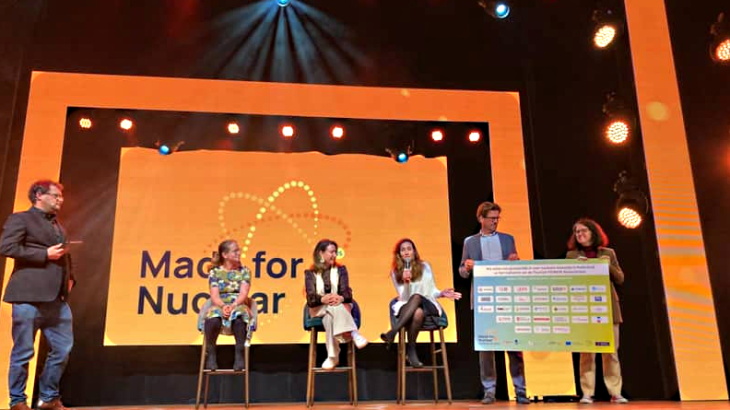The Jordan Atomic Energy Commission (JAEC) has signed a memorandum of understanding (MoU) with X-energy to assess the US company's small modular reactor (SMR). They will look at the potential deployment of X-energy's Xe-100 high temperature gas-cooled pebble bed modular reactor in Jordan.
The Xe-100 is a 200 MWt (75 MWe) reactor, which X-energy envisages being built as a standard "four-pack" plant generating about 300 MWe. The plant will use 'pebbles' of fuel containing Triso fuel particles. Each Triso particle has a kernel of uranium oxycarbide (also known as UCO) enriched to 15.5% uranium-235, encased in carbon and ceramic layers which prevent the release of radioactivity. The layers provide each particle with its own independent containment system, while the graphite surrounding the particles moderates the nuclear reaction. Such fuel cannot melt down.
.jpg) |
| A cutaway of the Xe-100 reactor design (Image: X-energy) |
JAEC chairman Khaled Toukan said, "The HTR's potential, once implemented, provides Jordan with opportunities that include both electric generation and non-electric utilisation such as water desalination and industrial applications and is the nexus between 3rd and 4th generation technologies."
X-energy CEO Kam Ghaffarian said, "Delivery of our Xe-100 for electricity, water desalination and other thermal applications in Jordan represents a breakthrough for the advanced nuclear reactor industry."
He added, "As we work to bring our Xe-100 to markets worldwide, we will continue to create alliances with other potential customers that share the Kingdom of Jordan's goal for clean air, fresh water and energy security. This MoU is a demonstration of our commitment to provide distributed and clean energy solutions to countries like Jordan."
US research into high-temperature gas-cooled reactors (HTGRs) began in the 1940s at Oak Ridge National Laboratory, and X-energy's reactor design builds on earlier US Department of Energy (DoE) studies. Demonstration HTGR plants of various designs have operated in Germany, the UK and the USA, and two are currently operable - Japan's HTTR, and China's HTR-10.
In January, X-energy was awarded cost-shared funding of $53 million over five years from the DoE to support the development of the Xe-100, working in partnership with BWX Technology, Oregon State University, Teledyne-Brown Engineering, SGL Group, Idaho National Laboratory and ORNL.
In September, Greenbelt, Maryland-based X-energy signed an MoU with uranium enrichment company Centrus. Under the MoU, the two parties will work towards the development of a fabrication facility to provide Triso fuel for the Xe-100 reactor. The companies will jointly prepare a deployment plan for the fuel technology; design a cost-effective, highly automated manufacturing process line; and seek funding for a future commercial fuel production facility.
Jordan, which relies on imports to meet some 90% of its energy needs, plans to build a nuclear power plant, comprising two 1000 MWe units, in the Amra region, about 70 kilometres east of Amman. It is aiming to have the first unit in operation by 2021 and a second one by 2025. Jordan has already selected Russia as the preferred bidder for the plant. Russia will also make a significant investment in the plant.
Small reactors are also on Jordan's agenda. In November 2013, JAEC said it would build several small reactors of about 180 MWe capacity. In March this year, an agreement between JAEC and Saudi Arabia's King Abdullah City for Atomic and Renewable Energy was signed for a feasibility study on construction of two SMRs in Jordan. Earlier this month, JAEC signed an MoU with Rolls-Royce to conduct a feasibility study for the construction of an SMR.
Researched and written
by World Nuclear News




_34792.jpg)
_16403_79272.jpg)



_76087_55556.jpg)



